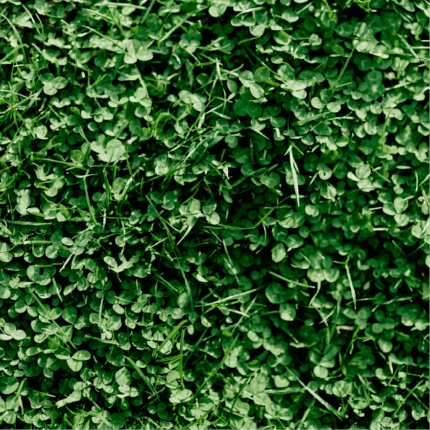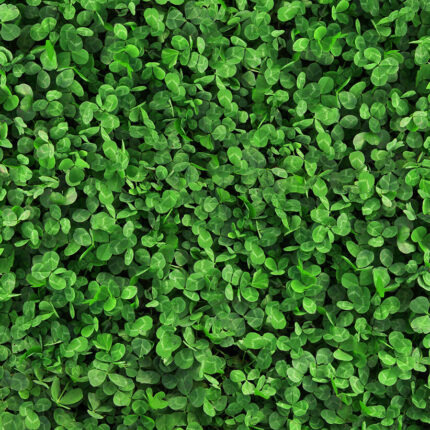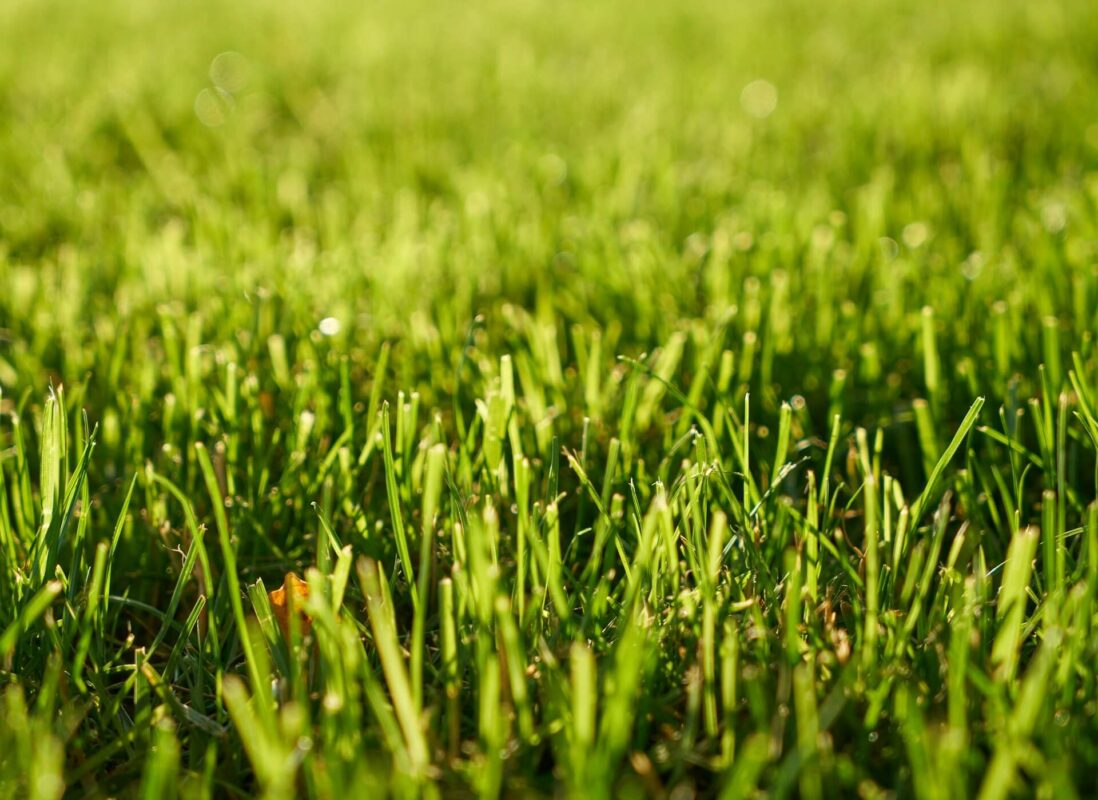The Micro Clover Lawn Trend: How Great is Microclover?

One of the biggest trends in landscaping and gardening continues to be the addition of regular clover, as well as the varieties of tiny white clover and micro clover plants that have been developed to create a neater, more pleasant appearance.
For Nature’s Seed, microclover seeds are one of our most popular products. While we provide pasture, wildflower, and lawn grass seed, we also want to help our customers create vibrant landscapes that are uniquely their own. Hence our stock includes perennial clover plants like verdant microclover. Browse our immense selection of seeds and find the right mix for your future lawn, garden, or pasture.
Below, we discuss what microclover is and what makes it different, as well as its benefits and drawbacks for your lawn, how to introduce it to your lawn, and how to best maintain it for a healthy, well-managed lawn.
What is Microclover?
Microclover is a popular type of tiny white clover that was developed to have smaller leaves, fewer flowers, and reduced habit of growth compared to regular clover plants. More specifically, microclover is known as Trifolium repens var. Pirouette.
Because of its smaller size and less dense appearance on lawns, more home and property owners are looking into planting microclover as part of their lawns or pastures. Planting micro clover in one’s lawn offers a number of additional benefits, adding to the already well-desired reasons to include them, as well as other types of Dutch white clover in your lawn mix.
Find High-Quality Dutch White Clover Seed from Nature’s Seed
Benefits of Adding Micro Clover to Your Lawn
To determine whether microclover plants are a great choice for one’s lawn, it’s important to find out what advantages are driving its recent recognition and popularity among landscapers and gardeners. Here are some benefits that micro clover may provide your landscape:
Microclover is More Drought Tolerant Than Turf
Among the biggest reasons landscapers and gardeners regard microclover so highly is because it has better drought tolerant properties than turf grasses such as Kentucky bluegrass. This is because micro clover seeds establish root systems deeper than conventional turf grass, which means they require less water than grass. These attributes make microclover a resilient choice for lawns and pastures. Despite this, it still needs to be routinely watered, requiring extra water during the hot summer months.
Micro Clover Creates a Self-Sustaining Lawn
Another great benefit of adding microclover to your lawn is that it ostensibly produces a self-sustaining lawn that requires less maintenance than other plant and grass mixes.
This is because, like other perennial clover plants, microclover can absorb nitrogen from the atmosphere, providing it as a natural source for surrounding grasses and plants and ensuring your lawn is greener and lusher throughout the year.
A Microclover Lawn is Easier to Maintain
Microclover is also well-favored because it is easier to maintain than other lawn or pasture plant mixes. Microclover was developed to grow at a slower rate and up to a lower height. This means adding it to your lawns requires less mowing over time compared to a more traditional lawn.
Microclovers Attract Good Bugs & Chase Out Bad Ones
Yet another incredible benefit of having microclover as part of your lawn is that it reduces the number of lawn pests, like grubs and beetles, reducing the need to use pesticides in order to protect your other plants. It also attracts pollinators like bees, creating a safe and healthy environment across your yard or pasture.
Microclover Easily Blends With Your Grass Lawn
Microclover is also known to blend well with certain varieties of grasses, creating beautiful, vibrant lawns and pastures. When added along with grass lawns, microclover can fill bare spots and make sure your entire landscape looks lush, green, and full.
Microclover Reduces Weed Growth
Finally, one of the best reasons for favoring microclover is that it can reduce weed growth in your yard or pasture. It does this by overcrowding and out-competing weeds with its dense root structure, eliminating weeds and making more room for grass.
Those are just some of the benefits that come from adding microclover to your lawn or pasture plant mix. However, it may not be perfect for everyone. Make sure to consider your local climate and the conditions of your surrounding environment, then reach out to longtime experts to get the best microclover and lawn seed mix possible.
Get Premium-Quality Microclover Seed from Nature’s Seed
Drawbacks of Having Micro Clover in Your Yard
While adding microclover to one’s yard can bring numerous benefits, there are some drawbacks that may deter some from including it. Here are a few things that may hinder you from wanting to plant micro clover on your lawn:
Micro Clover Lawns May Not Appeal To Everyone
Many property owners seek a traditional lawn that appears clean-cut and uniform in appearance. However, adding microclover to the already existing growth of your lawn may disrupt this uniformity, making it less appealing to certain individuals.
Microclover is Invasive
Another potential drawback of growing microclover on your existing lawn is that it can spread rapidly across your lawn, possibly invading areas you may not want it to grow in. In certain cases, it may even outcompete certain plants and grasses, making it an unintentionally dominant plant in your yard’s ecosystem.
Dead Microclover Can Produce a Thatch Layer
Over time, dead grass and other plants decompose into the ground, sometimes creating a thatch layer above your soil. In some cases, mismanaged microclover can quickly develop a thatch layer, making it difficult for water to penetrate into the soil and could potentially kill your lawn.
Micro Clover Looks Less Appealing During Winter
During the winter, microclover tends to turn brown in color. This doesn’t mean the plants have died but rather have gone into winter dormancy. It may not occur often in very warm winter areas, but in areas with high freezing winter temperatures, this effect can make your lawn look much less appealing compared to other plants that are more cold-hardy.
Microclover is Sensitive to Herbicides
Another drawback of having microclover as part of your lawn is that it is weak to most broadleaf herbicides, making it that much more difficult for you to eliminate broadleaf weeds. This can be a big problem for some, making microclover an undesirable choice to add to their lawn or pasture mix.
Microclover Attracts Bees
While bees are natural pollinators that can help foster the growth of many plants across your landscape, some might find the fact that microclovers attract them as a negative trait. Whether you are allergic to them or see them as another pest that disturbs the peace you want to find in your landscape, this could be yet another drawback for some.
Learn everything you can about micro clover seed, white dutch clover, and other types of pasture or lawn mixes before adding them to your yard
Developing Microclover with Lawn Grass
If you decide to add microclover to your lawn, there are a number of practices to follow so that you grow it properly and get the most from its benefits. Here are some crucial steps to take when introducing micro clover to your existing lawn:
- Check for compatible grass – Before anything else, do research, speak with experts, and find out if the grass in your existing lawn is compatible with microclover. Fine fescues and certain types of Kentucky bluegrass mix well with it. On the other hand, if your current grass doesn’t work with a microclover, yet you desire a microclover and grass lawn, we would recommend removing existing growth and revegetating with new microclover and lawn grass seeds.
- Preparing soil surface – While checking the current state of your lawn, also be sure to test the soil to determine if its pH and nutrient levels are a good fit for microclover, which prefers a slightly acidic to neutral pH. If you aren’t certain if it will fit, make sure to discuss the matter with seed experts. Furthermore, perform essential soil preparation practices, such as tilling the soil, removing rocks and debris, as well as leveling the ground.
- Sowing seeds – After a thorough soil prep, you can either mix grass and microclover seeds yourself or purchase a mixed microclover and grass seed blend from a trusted source like Nature’s Seed. Use a broadcast spreader or similar tools to scatter seeds densely around your lawn or pasture. Then, gently compress seeds into the soil using a roller or by walking around the sowed area, ensuring solid seed-to-soil contact.
- Watering seeds – Initially, you’ll want to water the area thoroughly after you plant microclover seeds, ensuring the soil is moist but not soggy. After the microclover and grass lawn have been established, you’ll be able to water it a bit less as both are quite drought-tolerant. However, during particularly long periods of dry and hot weather, it is necessary to give your microclovers a good, deep watering to ensure they stay hydrated and also to keep your lawn or pasture looking its best.
In addition, the best time to plant microclover is during the early fall and spring. Make sure to plant the seeds two weeks before the last frost date and eight weeks before the first average frost date in the fall season. Furthermore, avoid planting during the time of year when you experience the hottest temperatures, as microclover prefers cooler temperatures.
Maintaining Microclover
Once you have established your microclover and grass lawn, you’ll want to maintain its healthy and lush appearance. This requires sticking to this set of routine practices that ensure a continuously beautiful microclover and grass lawn:
- Mow less frequently – Because microclover grows at a much slower rate than traditional lawn grasses, you should mow it less frequently. In addition, when you do, cut at a height of around 3 inches, as this will allow the microclover to flower and attract bees and other pollinators during the spring.
- Fertilize with care – As mentioned previously, microclover is a natural fertilizer, as it is able to fix nitrogen and provide it to grasses and other plants in the surrounding area, thus reducing the need for you to fertilize them. However, if you would like to fertilize your grass, microclovers, and other plants, be sure to use one that is friendly to micro clover growth, as there are many types of lawn fertilizers that are harmful to it.
- Overseed – As your lawn continues to grow and mature, consider overseeding it with the same mixture of grass and microclover seeds every one or two years so that there is a healthy balance of both as time goes on while also rejuvenating the lawn’s integrity.
- Remove weeds carefully – Most herbicides are harmful to microclovers, so if you are seeking to remove some particularly difficult weeds from your lawn or pasture, consider using a microclover-safe herbicide or pulling them out by hand.
- Watch out for overcrowding – If you notice that your micro clover has begun to overcrowd the rest of our lawn’s grass, it is a good idea to mow more frequently to reduce its spread and also lower the number of micro clover seeds you use next time your are planting your grass-micro clover seed mix.
Properly maintaining a microclover-grass lawn is simpler than for most traditional lawns but still requires consistent care and attention to detail, as the continued health of your microclover lawn requires you to consider the conditions of your surrounding area and the overall environment. To ensure you get the best out of your micro clover lawn, talk to experienced seed experts.
Find the Best Seed for Your Landscape with Our Seed Selector Tool
Get the Best Micro Clover Seed from Nature’s Seed
Adding microclover to your well-manicured lawn will make it lusher, healthier, and more appealing throughout the spring and summer. It is also an enduring plant to include in your garden, lawn, or pasture. These are just a few of the reasons why it’s such a popular item of ours.
Nature’s Seed provides top-quality micro-clover seed, as well as a wide variety of pasture, wildflower, and lawn seed mixes. Contact us today, and our experts will help you find the absolute best seeding mix for your property.
Frequently Asked Questions About Microclover
How Much Does Micro Clover Seed Cost?
The precise cost of micro clover seed depends on a number of factors, such as the brand, quality, where you are purchasing it from, and whether or not it is a grass-microclover seed mix or a pure micro clover mix. Furthermore, prices tend to fluctuate over time and across different regions.
Nature Seed’s own Microclover® seeds provide a 0.5 lb bag that covers 500 sq ft and a 1 lb bag that covers 1000 sq ft, enough to cover plenty of your lawn or pasture. Order today, and we’ll ship a fresh bag of our best microclover seed right to your door.
Does Microclover Handle Foot Traffic Well?
No, microclover is delicate against heavy foot traffic. If you are seeking to add it to your lawn, make sure to add it in areas where very little activity occurs. What’s better is to mix your micro clover with turf grass seeds so that your lawn or pasture can better handle foot traffic – it is important to note that even this mix can only withstand moderate foot traffic throughout the year.
How Much Should I Water Microclover Lawns?
Because of its high drought tolerance, you aren’t required to water it very often. However, if you want to help it achieve optimal growth, particularly when it is first establishing itself in the soil of your lawn, make sure to water your micro clover regularly.
Is Microclover Safe for Pets?
Yes, micro clover is a pet-friendly plant that won’t have a harmful effect if it were to be ingested by a curious house pet. However, it is still advised to ensure pets don’t consume it excessively, as it may cause similar effects as over-eating other plants inside and outside your home.


